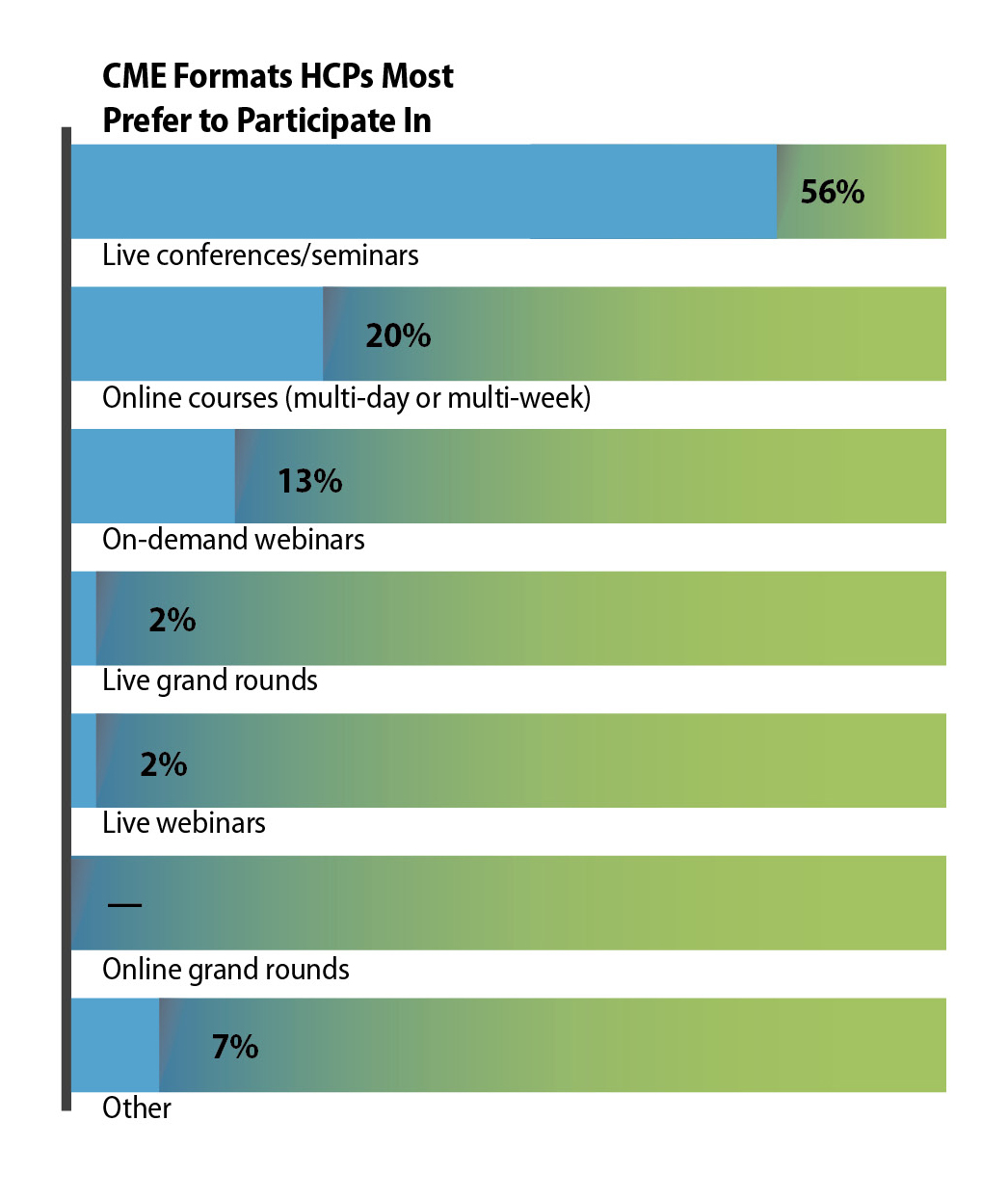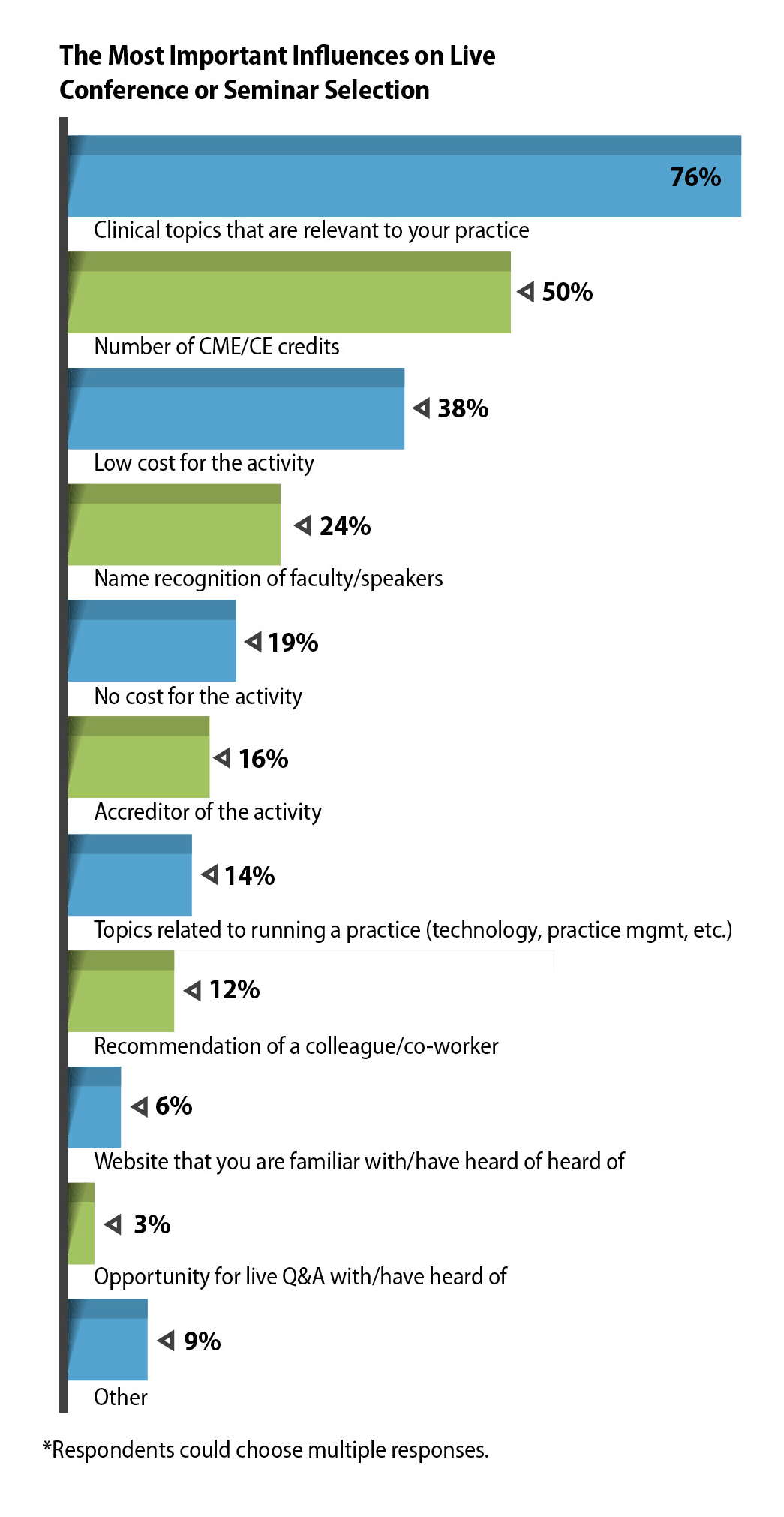Your continuing medical education activity has the top subject matter experts talking about the hottest topic in your clinical area—but you still can’t get healthcare professionals to sign up. What gives?
Part of the problem is the ever-growing plethora of options available. As Tristan Gorrindo, MD, deputy medical director of the American Psychiatric Association says, “There are so many options that it is hard to know what is quality and what is not.” And, of course, many HCPs are in the same boat as the respondent who says, “I find it hard to get away for CME; I am not given any CME time and have to use vacation time.”
MeetingsNet partnered with Charge Ahead Marketing and SK&A to find out what influences HCPs’ decisions to attend a CME activity, the types of activities they prefer, and the best way to communicate with them about CME offerings. Here are key findings from the study that will help you market your CME/CE programs more effectively.
They Like It Live
Almost 80 percent say live conferences and seminars are the medical education and training format they participate in most. It was also hands-down the format they say they most preferred, according to 56 percent of respondents.
Glenn Laudenslager IV, president of Charge Ahead Marketing, says he isn’t surprised by these findings. He notes that live conferences consistently rank as the most preferred format of education, at least in part because of the networking with peers and key opinion leaders. “So, it’s important to foster networking during your live conferences. And to hone in on those opportunities as part of your marketing message.”
Online multi-day or multi-week online courses also scored highly, with 57 percent saying they get CME through that medium. On-demand webinars are popular with about a third of respondents, while 29 percent say live grand rounds are high on their educational agendas.
The format that comes in lowest on the preference list is online grand rounds. While almost 12 percent say they participate in them, no one marked this as a format they most prefer. And while a quarter say they participated in live webinars, only 2 percent say they want to get their CME that way.

Email Is Alive and Kicking
What’s the best way to reach potential attendees? While 68 percent of respondents say email is how they usually hear about CME/CE programs, “The statistic itself doesn’t reflect the competing demands of the inbox,” says Laudenslager. “It is a challenge to gets emails delivered, opened, read, and clicked.” Instead of using email strictly as a way to acquire registrants, it is much more effective when used as a tool to nurture relationships and provide ongoing value through content, he says.
“Use what you know about customers and make your email relevant. Have they accessed content on a certain topic? What do you know about their age, profession, employer, location, education level, interests? When have they visited your website or clicked on an email? Use that information to tailor your email content. That is how you get your emails opened, links clicked, and actions taken,” he says.
Communications from professional associations also rank high on the list of common ways HCPs find out about CME activities, at 46 percent, followed by direct mail, journals, word of mouth, and Google searches. At the bottom of the list are employers and social media.
It’s not surprising that professional associations get their attention, adds Laudenslager. “This aligns with data from the Accreditation Council for CME annual report, where they are the second largest provider of education after hospitals and health systems.” HCPs also tend to be loyal to their professional societies. As one dermatologist notes, he prefers to get as much of his CME as he can from the American Academy of Dermatology. Another physician adds that he goes to his professional society’s annual meeting each year—and any other meeting he’s invited to as a speaker. “For special state-licensing-required topics, I go to the lowest-priced online provider I can find by searching.”
In fact, when asked the primary way HCPs learn about CME/CE programs, online searches jump from sixth place to third. “Today, it is important to invest in and understand search engine marketing, search engine optimization, and content marketing,” says Laudenslager. “These tactics are cost-effective and provide a sustainable return for your marketing budget.” While journals are the fourth most common way HCPs hear about CME programs, only 3 percent say this was a primary source for them—“Journals are a non-factor related to CME and education,” says Laudenslager.

Key Decision Influencers
While you may think that scoring faculty and speakers with high name-recognition will drive HCP participation for your online and live activities, less than a quarter of respondents say it is an important factor for them. Clinical topics relevant to their practice is tops for 76 percent when it comes to both online and live activities, followed by the number of CME/CE credits, and a low (or no) cost to attend. Further down the list are factors such as the activity’s accreditor, topics related to the business of running a practice, and recommendations from a colleague or co-worker. As one respondent says, “I pick CME events according to what my educational and practice needs are and to keep up to date.”
“The main takeaway is that, when marketing CME activities, factors like relevance and value should drive the messaging,” says Laudenslager. “Focus on popular or controversial clinical topics, and the actual benefits of attending (enhanced clinical skills, better outcomes for patients, etc.).”
Keeping the cost proportional to the perceived value also is key. While 21 percent say they don’t have to pay any out-of-pocket expenses for their CME/CE participation, a third say they pay for at least half—almost a quarter say they are on the hook for more than 75 percent of the costs—and 61 percent pay for at least 10 percent of it. But whether they pay out of pocket or not, HCPs still need to be convinced that the value they’ll get is worth the expenditure.
“It’s important to focus on the benefits—things like the cost versus the number of CME/CE credits, comparative analysis between your events and your competitors’ events—to help participants justify the cost of participation,” says Laudenslager.

How Important Is CME/CE Credit?
More than half of HCPs say CME/CE credit is a key deciding factor—second only to the relevance of the clinical topic.
However, 72 percent say they also participate in education that does not provide CME/CE credits. This flies in the face of the common wisdom that physicians won’t make the time to participate in credit-free education. One physician says that if the subject and/or location can make it worth his time, he will attend an activity that doesn’t offer CME credit. Another says her deciding factors would be “the topic, or information to be learned, the timing of the event so that it does not conflict with work hours, and the location.”
“This signals an opportunity to provide content that costs less time and money to create (no accreditation fees, for example), yet provides high perceived value,” says Laudenslager. “This is a perfect opportunity for content marketing, which is an important and effective marketing tactic that all CME providers should use.”
How Wired Are HCPs?
More than 80 percent of respondents use a smartphone or tablet in their practices—which means you have an opportunity to reach clinicians via mobile devices, says Laudenslager. However, you don’t want to spin your wheels with emails that don’t drive engagement. “It is critical to create your emails with a mobile-first perspective. They should be responsive, have the most important information visible within the first mobile screen (i.e., without scrolling), and have engaging content. If you’re asking for an hour of their time for a webinar or to stop their day and register for a conference, unless that email is personalized and compelling based on their behavior and profile, that email is going to get tuned out.”
Also, 62 percent of the HCPs surveyed participate in social media, which for Laudenslager signals the need to make social media a meaningful part of your marketing strategy. “And not just by putting up self-serving content. You have to create compelling content. Algorithms from Facebook and Google changed, for example, to prioritize content that people actually engage with. Content that gets liked, shared, commented on, etc. Without that engagement, you get very low organic reach.” He adds that social media also can be a valid paid advertising option, though costs are increasing.
When it comes to tracking CME activities and credits on a single website, app, or other system, almost two-thirds don’t. As one says, “I keep an old-school folder at work with all my certificates… it is cheap and easy.”
“Many docs are still disorganized, to my surprise,” adds another respondent. This physician, who was among the 38 percent who do use a single source, leans on his professional association’s transcript program to do the tracking, something that is free to all members. One nurse practitioner respondent says she uses the American Nurses Credentialing Center tracking system, which makes it easy to submit when it comes time to renew her certification. “I also keep a separate file (paper) of the CME certificates and any expenses related to them for income tax purposes,” she says. “My son wants me to end the paper accumulation and scan them into the computer, but I have not gone paperless just yet. I think the reason that most healthcare providers do not use a single source to track CME certificates is lack of awareness of what tracking systems are available.”
This could be an opportunity for portals and bigger websites to target their highly engaged users and message them about the value of using a single source, says Laudenslager. “What this also implies is that, and we hear this anecdotally also, that physicians have less loyalty than ever to CME providers.” Several survey respondents added to the anecdotal pile with comments that they and their colleagues don’t hold any particular allegiance to any one CME source. “I am not loyal to certain CME providers,” says one. “I will use whatever gives me the most value for my CME hours.”
As Gorrindo with the American Psychiatric Association says, “At the end of the day folks are looking for a trusted partner to help them find credible CME. We see that in the preference for professional associations. I think this provides a lot of opportunity for these trusted sources to use things like social media to engage learners, but unknown or new organizations will have a tough time engaging new ones without some trust in their brand.”
Methodology and Demographics
Data was collected via an email survey in fall 2017 to a wide range of U.S. healthcare professionals. The 129 usable responses were analyzed by Informa Engage Research, the research arm of Informa, MeetingsNet’s parent company. Physicians comprise 73.4 percent of respondents, which also included nurse practitioners (11.7 percent), physician assistants (9.4 percent), nurses (0.8 percent), and other HCPs (4.7 percent). The majority—83 percent—were between 35 and 64 years of age, fairly evenly split between the 35–44, 45–55, and 55-60 age brackets. Just under 8 percent were 65 or older.





